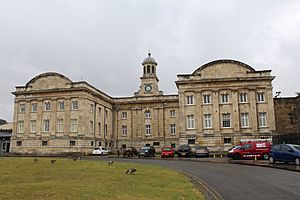York Debtor's Prison facts for kids
Quick facts for kids York Debtor's Prison |
|
|---|---|
 |
|
| Location | Eye of York, York, North Yorkshire, England |
| OS grid reference | SE 60384 51443 |
| Built | 1701-1705 |
|
Listed Building – Grade I
|
|
| Designated | 14 June 1954 |
| Reference no. | 1259360 |
| Lua error in Module:Location_map at line 420: attempt to index field 'wikibase' (a nil value). | |
The York Debtor's Prison is an old building in York, North Yorkshire. It used to be a special kind of prison for people who owed money. Today, it is a very important historic building, known as a Grade I Listed building. Since 1938, it has been a part of the York Castle Museum, where visitors can learn about its past.
Contents
History of the Prison Building
The Debtor's Prison was first built between 1701 and 1705. It was originally the main prison for the county. The building is located near Clifford's Tower, inside the old castle grounds.
It is a large building with three floors. It has a central part with a clock tower. On each side, there are wings that stick out. The prison was built using strong Tadcaster limestone and bricks. Its roof is made of lead and slate. Some of the stone used came from older parts of Clifford's Tower and King's Manor. The prison was made bigger between 1824 and 1835.
Famous Prisoners
One of the most well-known people held at the prison was Dick Turpin. He was a famous highwayman. Turpin was kept here in the 1730s before his trial. You can still see what is believed to be his cell today. It is part of the museum's exhibits.
The Castle's Role in Justice
In the early 1800s, the area around York Castle became the main place for public punishments in York. This replaced an older site called Tyburn. A new gallows was set up on March 8, 1801. It was first used on April 11, 1801. People who were found guilty of serious crimes were punished here. This area was known as 'the Drop'. It was located between the Assize Courts and the castle wall, right next to the Debtor's Prison. This continued until 1868. After that, punishments took place inside the prison walls. This happened at the north end of the Female prison until 1896.
Images for kids


